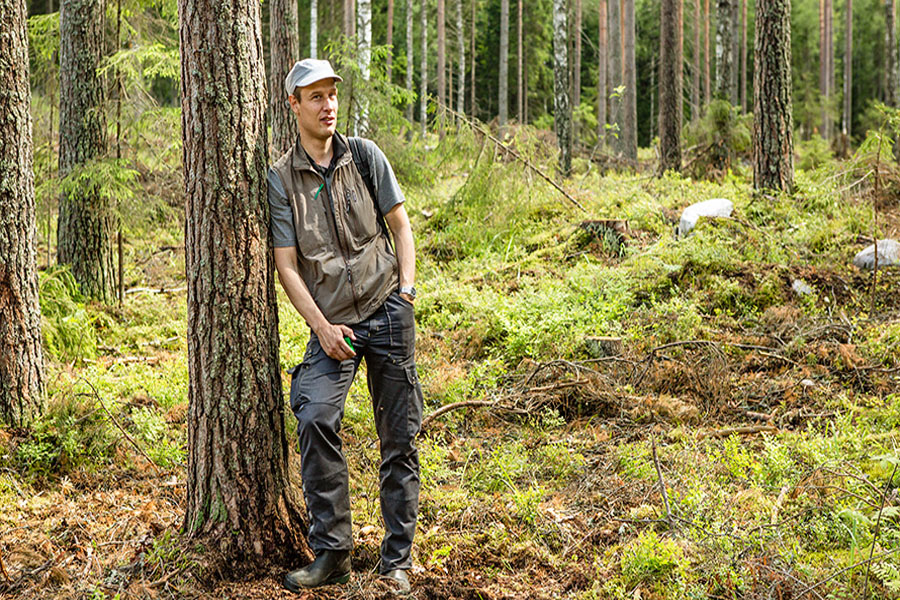 Biodiversity visible in commercial forests
Biodiversity visible in commercial forests
For two decades, UPM has systematically developed methods for securing biodiversity in sustainably managed commercial forests.
Mikko Pirilä, a forest specialist working for UPM in the Kanta-Häme region of Finland, has been managing forests for over 15 years. Pirilä studied forestry in Joensuu and originally became interested in forest engineering after taking up orienteering as a hobby.
“There were several forest professionals among my orienteering friends. They gave me an idea of what the work might be like and I took a liking to the forestry field. In addition to orienteers, there are also many skiers, hunters and nature enthusiasts among forest specialists,” Pirilä says.
Forest specialists get to spend time in forests as part of their everyday duties. Approximately half of Pirilä’s working week is spent at the office and half in the field.
“In forests owned by private individuals, we examine the condition of the forest and the management measures needed while taking the goals of the forest owner into account. A day in the forest can include planning stands to be cut and using laser scanning data to estimate stand volumes and determine species found in the forest,” Pirilä says.
The majority of the work consists of making felling plans and determining areas to be cut.
“When we determine areas to be cut, we strictly comply with statutory requirements concerning matters such as the conservation of valuable habitats. Naturally we also listen to the forest owners’ opinions and take into account any requirements set by forest certificates, if forests are included in a certification scheme,” Pirilä adds.
“Discussing felling plans with forest owners provides us with the opportunity to agree on other forest management-related issues, such as thinning, seedling stand management and any other forestry work that may be needed. If a forest owner wishes to boost forest growth, we can also determine the areas suitable for fertilising.”
Seeking to create biodiverse habitats
UPM’s biodiversity programme aims to promote best practices in sustainable forest management in commercial forests.
“UPM’s biodiversity programme is a meaningful and motivational tool for employees who plan cutting areas. Our work gives us a concrete idea of how selecting cutting areas and making changes in accordance with guidelines affects the environment and forest management in practice. When the end result is good, you know that you have succeeded in your work,” Pirilä says.
A large number of specialists from ecologists and biologists to foresters have participated in developing the UPM forest biodiversity programme. The programme promotes nature management alongside harvesting and forest management.
“When harvesting is performed, rowans, alders and junipers are left to grow in order to maintain the diversity of tree species. This ensures that forests do not consist solely of the species being grown, such as pine, birch or spruce. Windfall trees and deadwood are also left in forests for micro-organisms and insects to live on. In seedling stand management, we try to avoid excess clearing.”
Maintaining biodiversity, protecting water resources, and taking climate issues and multiple-use of forests into account are increasingly important in today’s forest management.
“Water resources are taken into account at an early stage when forest management activities are being planned, for instance by ensuring that stands to be fertilised are located outside groundwater areas. Strictly defined watercourse buffer zones are also applied to lakeshores and around other bodies of water in order to reduce the impacts forestry has on the environment.”
Forest biodiversity helps the environment to withstand the effects of climate change, which is important if we want species to thrive and remain healthy.
A long term approach to forest management
Finnish forestry has always been based on sustainability, regardless of whether the indicators used have been ecological, financial or social. In forests that are sustainably managed, more trees grow every year than are harvested.
The Finnish Forest Act, Water Act and Nature Conservation Act provide strict regulations for forestry. Forest owners can also choose to include their forests in voluntary certification schemes, such as PEFCTM or FSC®. The requirements of these schemes add to the obligations of forest owners.
“In addition to forest management, today’s forest owners also emphasise other values, such as recreational use and nature conservation. Forest management is a long term project. The number of young forest owners living in cities has increased, and maintaining biodiversity is increasingly important to these forest owners. FSC forest certification is particularly popular among this owner group. Forest owners can join the certification scheme through UPM’s FSC group certificate FSC C 109750,” Pirilä says.
In Southern Finland, commercial forests make up a significant share of all forests. Pirilä estimates that forests in the area could be utilised more efficiently than is currently being done. The Kanta-Häme region is one of the areas where harvesting is backlogged, although forest management in the region is relatively efficient.
Recognition for UPM’s responsible work
UPM recently received recognition for its biodiversity work in a competition organised by FIBS, the leading non-profit corporate responsibility network in Finland. The award came for UPM’s biodiversity reporting included in the company’s annual report 2015. The competition panel evaluated the corporate responsibility reports of all the companies listed on the NASDAQ OMX Helsinki stock exchange.
According to the panel, UPM’s report comprehensively describes the company’s biodiversity-related policies and management practices, and biodiversity has been tied into the company strategy through global megatrends.
UPM has also succeeded in describing the effects its collaboration projects have had on species and in introducing stakeholder opinions on biodiversity. The report also includes a large number of performance measures shedding light on matters such as conserved forest areas and the share of certified wood used by the company.
